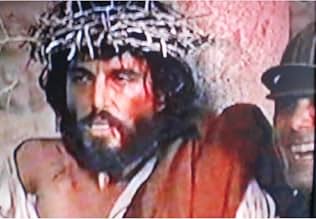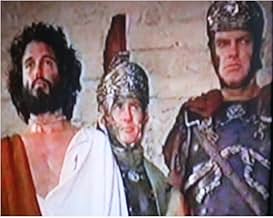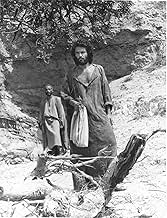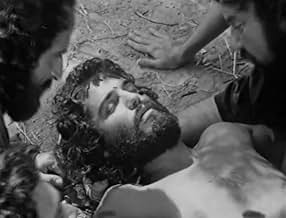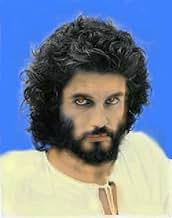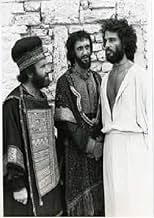IMDb RATING
5.9/10
143
YOUR RATING
The Crucifixion of Christ seen more from a political and historical point of view than a spiritual one.The Crucifixion of Christ seen more from a political and historical point of view than a spiritual one.The Crucifixion of Christ seen more from a political and historical point of view than a spiritual one.
- Director
- Writers
- Stars
- Director
- Writers
- All cast & crew
- Production, box office & more at IMDbPro
Featured reviews
This film is very depressive. I think who wrote him/it and it accomplished him/it certainly it doesn't believe that Jesus Christ resurrected and it arose to the heaven. In this film they are shown the last 24 hours of Jesus of Nazareth (Chris Sarandon). He begins with their disciples Peter and John going the city of Jerusalem, to find a place to prepare the dinner of Easter, following by the Last Supper, the prayer, the betrayal and the prison in the garden of Gethsemani, the judgement before the one of Highest Priest Caiaphas and of the main priests, Peter's denial, the interrogation before Pilate, the judgement in which the people choose Barabbas to be freed in Jesus' place, the flagellation, the coronation of thorns, the mockeries done by the Roman soldiers, the via-crucis (in the which Jesus only carries a part of the cross and no the cross completes) and it finishes when Jesus has his/her hand preached by the torturer in the log of the cross, and the image frozen there. The following image is the in that it shows Caiaphas and Pilate tends a fast conversation, saying that it is everything finishing and one wanting Happy Easter for the other,... and end. This film has an exquisite and detailed production, sceneries of the streets, of the houses, of the palaces, characterization and clothes of the guards of the Temple, of the soldiers and Roman centurions, of the priests, of Pilate, of the people, in a way that I think it must really have been at Judea and in Jerusalem 2000 years ago. And this film was faithful to the text of the Gospel in some parts, but in other the increment of scenes and of speeches, it fled completely to the sacred text, distorting completely. Judas, the traitor, nor it seems to be with total certainty of the one that intends do. But the great flaw of this film was without a doubt showing Jesus' last 24 hours, their judgement, suffering in an extremely heavy and depressive way, much more than in the other films on Christ that I saw. As for actor Chris Sarandon, until he interpreted Jesus Christ with plenty of competence, but it is not adapted for the paper. He is the first actor to represent Jesus Christ, without having the traditional characterization as all we knew of Jesus. Chris Sarandon doesn't have the long hair as it demands the paper. I don't agree with a film that doesn't show Jesus resurrecting, appearing to the disciples and arising to the heavens. In this point I give note 0 for the idealizadores, the producers and the enterprising of this film.
Which will the intention of the enterprising ones have been and producing with this film?
Which will the intention of the enterprising ones have been and producing with this film?
This movie strikes me as one of the most successful attempts ever at coming up with plausible answers for some of the nagging questions that have cropped up in recent scholarship concerning the "Passion" (suffering and death of Christ) accounts in the New Testament. (What motivated Judas if money was not the issue? What could bring the Sanhedrin to meet on a high holy day? Why did Pilate waffle?) It is a movie for the serious, thinking Christian: fans of "The Passion of the Christ" will no doubt be disappointed by the lack of gory spectacle and arch characterization. As for myself, I find the portrait painted here--of the willingness of ordinary people to so blithely sacrifice common decency when their own self-interest is at stake--far more realistic and deeply unsettling. (The disinterested, "just doing my job" look on the face of the man who drives the first nail in Christ's wrist is as chilling as any moment in film.) The film makes no claim to "authenticity", but the settings and costuming invariably feel more "right" than many more highly acclaimed efforts. It is a slow film but, if you accept its self-imposed limits (it is, after all, "The Death"--not the Life--"of Christ"), ultimately a very rewarding one.
No doubt Mel Gibson watched this movie before he made his Passion, the similarities are clear. But what a joke! As a Jew who is NOT a Christian, but is a historian. I can tell you that I have never seen such a bad movie on the Jesus myth. Also, why is the Sanhedrin, the body of Jewish rabbis shown as a group of bumbling fools? The Sanhedrin were the top of the top of the intellectuals and scholars. If anything, the Romans who had near no education should have been the ones who looked like fools. Why are these Jews from ancient times wearing modern Jewish prayer cloths (Talletot)? And to have them hanging over their left shoulder only? Makes no sense at all. Also, the Sanhedrin is standing in a room surrounded by 9th century Morrish woodcut motifs. I would call this "Passion-Lite" because it is just as inaccurate as Gibson's movie, only it was done 24 years earlier.
This movie is one of the most provocative Jesus movies I have ever seen. It does not seek to tell the whole story, but only to portray an interpretive expression of the last day of Jesus Christ. It is darkly witty, playful and seriously faithful to elements of the Jewish tradition and to modern scriptural interpretation. Judas is much more ordinary than other portrayals, not the dark and sinister evil that we sometimes imagine, but a grossly mistaken man, horribly misguided in his zeal. Chris Saranden's Jesus is playful and serious, faithful and committed--very human while also divine. The final dialog is thoughtfully done and serves as the kind of small talk that two powerful men might do when they have just committed an atrocity. I would watch this movie again and recommend it to others.
It is a dialogue . Not the touching film, not the example of accuracy, not the lesson about The Savior. Just a honest dialogue about sensitive aspects of His last days and about the people motivations and gestures and expectations around Christ. Surprising fresness and the inspired slow rhytm are the basic virtues of a film proposing the reflection and not the show. Chris Sarandon propose a portrait who you feel as deep authentic. The dialogues are inspired crafted. And, not the last, its deep honesty is the great virtue , proposing not a vision but a provocative frame for old questions and sketches for significant posible answers. So, a beautiful, in special sense, film.
Did you know
- TriviaBoth Tony Vogel(Temple Guard) and Keith Michell(Pontius Pilate) have been also involved in three other Biblical portrayals.....Vogel portrayed Andrew in Jesus Of Nazareth in 1977 and in 1999 TV movie Jesus portrays a farmer.....Michell portrayed Jacib in 1974 in The Story of Jacob and Joseph and in 1977 portrays King David in The Story of David.
- Crazy creditsThe 20th Century Fox Television logo is shown without the fanfare.
- ConnectionsReferenced in Saturday Night Live: Richard Benjamin, Paula Prentiss/The Grateful Dead (1980)
Details
- Release date
- Country of origin
- Language
- Also known as
- The Day Christ Died
- Filming locations
- Tunisia(filmed entirely on location in Tunisia)
- Production company
- See more company credits at IMDbPro
- Runtime
- 2h 22m(142 min)
- Color
- Aspect ratio
- 1.33 : 1
Contribute to this page
Suggest an edit or add missing content

